小学英语主题教案
- 格式:doc
- 大小:19.00 KB
- 文档页数:5

小学英语教育教学教案设计(精选9篇)(经典版)编制人:__________________审核人:__________________审批人:__________________编制单位:__________________编制时间:____年____月____日序言下载提示:该文档是本店铺精心编制而成的,希望大家下载后,能够帮助大家解决实际问题。
文档下载后可定制修改,请根据实际需要进行调整和使用,谢谢!并且,本店铺为大家提供各种类型的经典范文,如总结报告、心得体会、应急预案、会议记录、条据书信、合同协议、规章制度、教学资料、作文大全、其他范文等等,想了解不同范文格式和写法,敬请关注!Download tips: This document is carefully compiled by this editor. I hope that after you download it, it can help you solve practical problems. The document can be customized and modified after downloading, please adjust and use it according to actual needs, thank you!Moreover, our store provides various types of classic sample essays, such as summary reports, insights, emergency plans, meeting minutes, evidence letters, contract agreements, rules and regulations, teaching materials, essay summaries, and other sample essays. If you would like to learn about different sample formats and writing methods, please pay attention!小学英语教育教学教案设计(精选9篇)小学英语教育教学教案设计(精选9篇)2024-04-14 12:07:23小学英语教学设计(精选6篇)推荐度:小学英语教学设计范文最新6篇推荐度:热点范文英语(英文:English)是一种西日耳曼语支,最早被中世纪的英国使用,并因其广阔的殖民地而成为世界使用面积最广的语言。
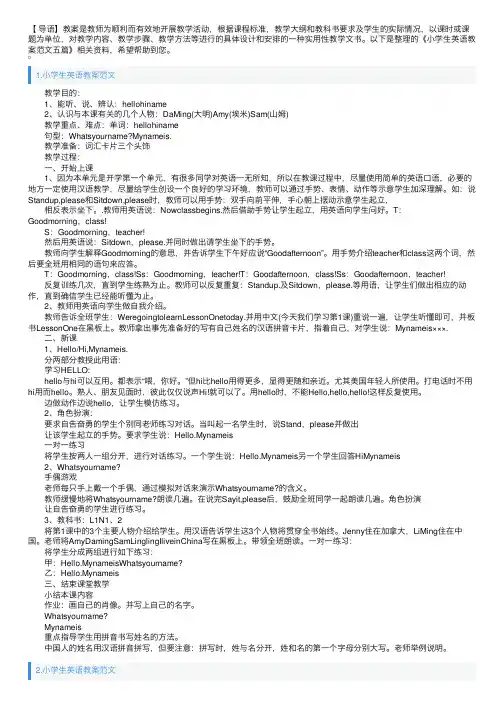
【导语】教案是教师为顺利⽽有效地开展教学活动,根据课程标准,教学⼤纲和教科书要求及学⽣的实际情况,以课时或课题为单位,对教学内容、教学步骤、教学⽅法等进⾏的具体设计和安排的⼀种实⽤性教学⽂书。
以下是整理的《⼩学⽣英语教案范⽂五篇》相关资料,希望帮助到您。
1.⼩学⽣英语教案范⽂ 教学⽬的: 1、能听、说、辨认:hellohiname 2、认识与本课有关的⼏个⼈物:DaMing(⼤明)Amy(埃⽶)Sam(⼭姆) 教学重点、难点:单词:hellohiname 句型:Whatsyourname?Mynameis. 教学准备:词汇卡⽚三个头饰 教学过程: ⼀、开始上课 1、因为本单元是开学第⼀个单元,有很多同学对英语⼀⽆所知,所以在教课过程中,尽量使⽤简单的英语⼝语,必要的地⽅⼀定使⽤汉语教学,尽量给学⽣创设⼀个良好的学习环境,教师可以通过⼿势、表情、动作等⽰意学⽣加深理解。
如:说Standup,please和Sitdown,please时,教师可以⽤⼿势:双⼿向前平伸,⼿⼼朝上摆动⽰意学⽣起⽴, 相反表⽰坐下。
.教师⽤英语说:Nowclassbegins.然后借助⼿势让学⽣起⽴,⽤英语向学⽣问好。
T:Goodmorning,class! S:Goodmorning,teacher! 然后⽤英语说:Sitdown,please.并同时做出请学⽣坐下的⼿势。
教师向学⽣解释Goodmorning的意思,并告诉学⽣下午好应说“Goodafternoon”。
⽤⼿势介绍teacher和class这两个词,然后要全班⽤相同的语句来应答。
T:Goodmorning,class!Ss:Goodmorning,teacher!T:Goodafternoon,class!Ss:Goodafternoon,teacher! 反复训练⼏次,直到学⽣练熟为⽌。
教师可以反复重复:Standup.及Sitdown,please.等⽤语,让学⽣们做出相应的动作,直到确信学⽣已经能听懂为⽌。
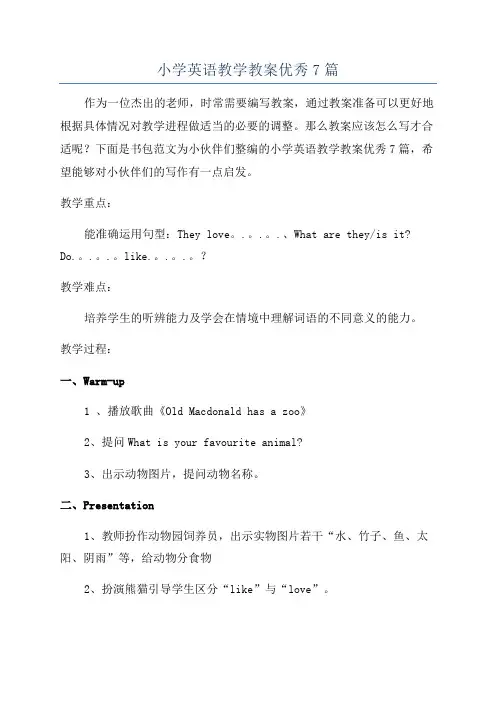
小学英语教学教案优秀7篇作为一位杰出的老师,时常需要编写教案,通过教案准备可以更好地根据具体情况对教学进程做适当的必要的调整。
那么教案应该怎么写才合适呢?下面是书包范文为小伙伴们整编的小学英语教学教案优秀7篇,希望能够对小伙伴们的写作有一点启发。
教学重点:能准确运用句型:They love。
.。
.。
.、What are they/is it? Do.。
.。
.。
like.。
.。
.。
?教学难点:培养学生的听辨能力及学会在情境中理解词语的不同意义的能力。
教学过程:一、Warm-up1 、播放歌曲《Old Macdonald has a zoo》2、提问What is your favourite animal?3、出示动物图片,提问动物名称。
二、Presentation1、教师扮作动物园饲养员,出示实物图片若干“水、竹子、鱼、太阳、阴雨”等,给动物分食物2、扮演熊猫引导学生区分“like”与“love”。
3、出示天气图片,通过对天气的喜爱程度,引导学生运用“like”与“love”。
三、Practice1、听活动一录音完成动物特征和喜好表格。
2、依据表格进行谜语创作。
四、Consolidation1、播放录音,让学生体会语调。
2、引导学生小组设计一组就动物习性进行的谈话,用准确的语调展示。
五、Summary引导学生整理本模块内容,介绍所学内容。
板书设计:Module7 Unit2 Pandas love bamboo。
Snakes love the sun。
What are they? Elephants like the water.They are.。
.。
.。
Pandas love bamboo.Dogs play with children.Cats like fish.一、设多彩情景,创课堂氛围众所周知,英语是一种语言,而非一般的知识。
语言的学习如果脱离了一定的情境,学生学习起来不但吃力,更不能很好地把握知识的用法。

小学英语教案20篇英文版小学英语教学是教育的基础,也是每一个孩子学习英语的开端。
为了帮助小学英语老师更好地开展教学工作,提高孩子的英语学习成绩,以下是20篇小学英语教案的英文版,供广大小学英语教师参考。
1. Title: Introducing MyselfContent: Students learn to introduce themselves in English.Objectives: By the end of the class, students should be able to introduce themselves inEnglish.Materials: PPT, pictures, handoutsProcedure:1. Warm-up: Greeting students and asking them about their names.2. Presentation: Using pictures to introduce oneself and providing examples.3. Practice: Students practice introducing themselves in pairs.4. Production: Students present themselves in front of the class.5. Evaluation: Checking students’ pronunciation and fluency.2. Title: ColorsContent: Students learn how to recognize and say different colors in English.Objectives: By the end of the class, students should be able to recognize and name different colors in English.Materials: PPT, flashcards, handoutsProcedure:1.Warm-up: Using colored flashcards to engage students.2. Presentation: Using PPT to show pictures of different colors and their names.3. Practice: Students match the colors with their names and practice saying them.4. Production: Students createtheir own pictures and describe them in English.5. Evaluation: Checking students’ ability to recognize and name different colors.3. Title: NumbersContent: Students learn how to recognize and say the numbers from 1 to 20 in English.Objectives: By the end of the class, students should be able to recognize and say the numbers from 1 to 20 in English.Materials: PPT, flashcards, handoutsProcedure:1. Warm-up: Using number flashcards to engage students.2. Presentation: Using PPT to show pictures of the numbers from 1 to 20 and their names.3. Practice: Students match the numbers with their names and practice saying them.4. Production: Students practice counting in English and count the number of objects in the classroom.5. Evaluation: Checking students’ ability to recognize and say the numbers from 1 to 20.4. Title: ShapesContent: Students learn how to recognize and name different shapes in English.Objectives: By the end of the class, students should be able to recognize and name different shapes in English.Materials: PPT, flashcards, handoutsProcedure:1. Warm-up: Using shape flashcards to engage students.2. Presentation: Using PPT to show pictures of different shapes and their names.3. Practice: Students match the shapes with their names and practice saying them.4. Production: Students create their own pictures using different shapes and describe them in English.5. Evaluation: Checki ng students’ ability to recognize and name different shapes.5. Title: FamilyContent: Students learn how to talk about their family members in English.Objectives: By the end of the class, students should be able to talk about their family members in English.Materials: PPT, flashcards, handoutsProcedure:1.Warm-up: Asking students about their family members.2. Presentation: Using PPT to show pictures of different family members and their names.3. Practice: Students practice talking about their family members in pairs.4. Production: Students present their family members in front of the class.5. Evaluation: Checking students’ ability to talk about their family members in English.6. Title: AnimalsContent: Students learn how to recognize and name different animals in English.Objectives: By the end of the class, students should be able to recognize and name different animals in English.Materials: PPT, flashcards, handoutsProcedure:1. Warm-up: Using animal flashcards to engage students.2. Presentation: Using PPT to show pictures of different animals and their names.3. Practice: Students match the animals with their names and practice saying them.4. Production: Students create their own pictures using different animals and describe them in English.5. Evaluation: Chec king students’ ability to recognize and name different animals.7. Title: WeatherContent: Students learn how to recognize and name different types of weather in English.Objectives: By the end of the class, students should be able to recognize and name different types of weather in English.Materials: PPT, flashcards,handoutsProcedure:1. Warm-up: Asking students about the weather outside.2. Presentation: Using PPT to show pictures of different types of weather and their names.3. Practice: Students practice recognizing and naming different types of weather.4. Production: Students describe the weather in a particular place.5. Evaluation: Checking students’ ability to recognize and name different types of weather.8. Title: Food and DrinksContent: Students learn how to recognize and name different types of food and drinks in English.Objectives: By the end of the class, students should be able to recognize and name different types of food and drinks in English.Materials: PPT, flashcards, handoutsProcedure:1.Warm-up: Asking students about their favorite food and drinks.2. Presentation: Using PPT to show pictures of different types of food and drinks and their names.3. Practice: Students practice recognizing and naming different types of food and drinks.4. Production: Students decide on a menu and describe the food and drinks in English.5. Evaluation: Checking students’ ability to recognize and name different types of food and drinks.9. Title: My BodyContent: Students learn how to recognize and name different parts of the body in English.Objectives: By the end of the class, students should be able to recognize and name different parts of the body in English.Materials: PPT, flashcards, handoutsProcedure:1. Warm-up: Asking students about different parts of the body.2. Presentation: Using PPT to show pictures of different parts of the body and their names.3. Practice: Studentspractice recognizing and naming different parts of the body.4. Production: Students draw a person and label the different parts of the body in Eng lish.5. Evaluation: Checking students’ ability to recognize and name different parts of the body.10. Title: JobsContent: Students learn how to recognize and name different types of jobs in English.Objectives: By the end of the class, students should be able to recognize and name different types of jobs in English.Materials: PPT, flashcards, handoutsProcedure:1. Warm-up: Asking students about their dream job.2. Presentation: Using PPT to show pictures of different types of jobs and their names.3. Practice: Students practice recognizing and naming different types of jobs.4. Production: Students choose a job and describe it in English.5. Evaluation: Checking students’ ability to recognize and name different types of jobs.11. Title: Days of the WeekContent: Students learn how to recognize and say the days of the week in English.Objectives: By the end of the class, students should be able to recognize and say the days of the week in English.Materials: PPT, flashcards, handoutsProcedure:1. Warm-up: Asking students about their favorite day of the week.2. Presentation: Using PPT to show pictures of the days of the week and their names.3. Practice: Students practice recognizing and saying the days of the week.4. Production: Students describe their schedule for the week.5. Evaluation: Checking students’ ability to recognize and say the days of the week.12. Title: Months of the YearContent: Students learn how to recognize and say the months of the year in English.Objectives: By the end of the class, students should be able to recognize and say the months of the year in English.Materials: PPT, flashcards, handoutsProcedure:1. Warm-up: Asking students about their favorite month of the year.2. Presentation: Using PPT to show pictures of the months of the year and their names.3. Practice: Students practice recognizing and saying the months of the year.4. Production: Students describe their favorite season and the months that belong to it.5. Evaluation: Checking students’ ability to recognize and say the months of the year.13. Title: TimeContent: Students learn how to tell the time in English.Objectives: By the end of the class, students should be able to tell the time in English.Materials: PPT, flashcards, handoutsProcedure:1. Warm-up: Asking students about their favorite time of the day.2. Presentation: Using PPT to show pictures of the clock and different times.3. Practice: Students practice telling the time in English.4. Production: Students plan their daily schedule and write it in English.5. Evaluation: Checking students’ ability to tell the time in English.14. Title: Weather ForecastContent: Students learn how to give a weather forecast in English.Objectives: By the end of the class, students should be able to give a weather forecast in English.Materials: PPT, flashcards, handoutsProcedure:1.Warm-up: Asking students about the weather outside.2. Presentation: Using PPT to show different weather conditions andvocabulary.3. Practice: Students practice giving a weather forecast in pairs.4. Production: Students give a weather forecast in front of the class.5. Evaluation: Checking students’ ability to give a weather forecast in English.15. Title: SeasonsContent: Students learn how to recognize and name the different seasons in English.Objectives: By the end of the class, students should be able to recognize and name the different seasons in English.Materials: PPT, flashcards, handoutsProcedure:1. Warm-up: Asking students about their favorite season.2. Presentation: Using PPT to show pictures of the different seasons and their names.3. Practice: Students practice recognizing and naming the different seasons.4. Production: Students write a paragraph about their favorite season in English.5. Evaluation: Checking students’ ability to recognize and name the different seasons in English.16. Title: ToysContent: Students learn how to recognize and name different types of toys in English.Objectives: By the end of the class, students should be able to recognize and name different types of toys in English.Materials: PPT, flashcards, handoutsProcedure:1. Warm-up: Asking students about their favorite toy.2. Presentation: Using PPT to show pictures of different types of toys and their names.3. Practice: Students practice recognizing and naming different types of toys.4. Production: Students describe their favorite toy in English.5. Evaluation: Checking students’ ability to recognize and name different types of toys.17. Title: School SuppliesContent: Students learn how to recognize and name different school supplies in English.Objectives: By the end of the class, students should be able to recognize and name different school supplies in English.Materials: PPT, flashcards, handoutsProcedure:1. Warm-up: Asking students about their favorite school supply.2. Presentation: Using PPT to show pictures of different school supplies and their names.3. Practice: Students practice recognizing and naming different school supplies.4. Production: Students describe the contents of their school bag in English.5. Evaluation: Checking students’ ability to recognize and name different school supplies.18. Title: Parts of a HouseContent: Students learn how to recognize and name different parts of a house inEnglish.Objectives: By the end of the class, students should be able to recognize and name different parts of a house in English.Materials: PPT, flashcards, handoutsProcedure:1.Warm-up: Asking students about the different rooms in their house.2. Presentation: Using PPT to show pictures of different parts of a house and their names.3. Practice: Students practice recognizing and naming different parts of a house.4. Production: Students describe their favorite room in their house in English.5. Evaluation: Checking students’ ability to recognize and name different parts of a house.19. Title: HolidaysContent: Students learn how to recognize and name different holidays in English.Objectives: By the end of the class, students should be able to recognize and name differentholidays in English.Materials: PPT, flashcards, handoutsProcedure:1. Warm-up: Asking students about their favorite holiday.2. Presentation: Using PPT to show pictures of different holidays and their names.3. Practice: Students practice recognizing and naming different holidays.4. Production: Students write about their favorite holiday in English.5. Evaluation: Checking students’ ability to recognize and name different holidays in English.20. Title: SportsContent: Students learn how to recognize and name different sports in English.Objectives: By the end of the class, students should be able to recognize and name different sports in English.Materials: PPT, flashcards, handoutsProcedure:1. Warm-up: Asking students about their favorite sport.2. Presentation: Using PPT to show pictures of different sports and their names.3. Practice: Students practice recognizing and naming different sports.4. Production: Students describe their favorite sport in English.5. Evaluation: Checking students’ ability to recognize and name different sports in English.以上是20篇小学英语教案的英文版,它们覆盖了小学英语教学的各个方面。
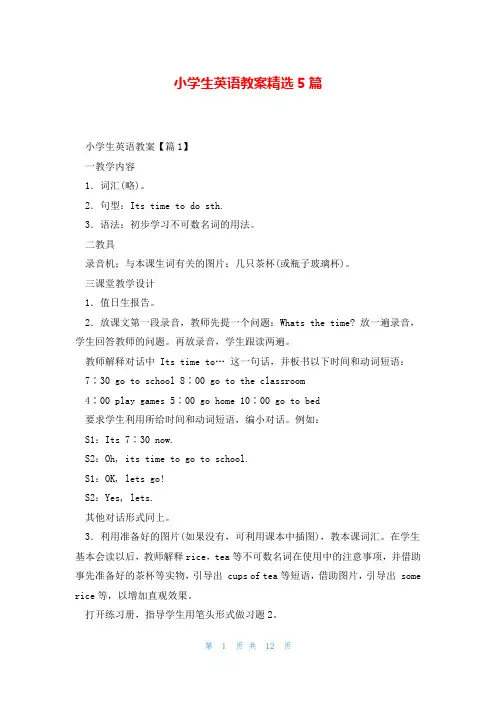
小学生英语教案精选5篇小学生英语教案【篇1】一教学内容1.词汇(略)。
2.句型:Its time to do sth.3.语法:初步学习不可数名词的用法。
二教具录音机;与本课生词有关的图片;几只茶杯(或瓶子玻璃杯)。
三课堂教学设计1.值日生报告。
2.放课文第一段录音,教师先提一个问题:Whats the time? 放一遍录音,学生回答教师的问题。
再放录音,学生跟读两遍。
教师解释对话中 Its time to…这一句话,并板书以下时间和动词短语:7∶30 go to school 8∶00 go to the classroom4∶00 play games 5∶00 go home 10∶00 go to bed要求学生利用所给时间和动词短语,编小对话。
例如:S1:Its 7∶30 now.S2:Oh, its time to go to school.S1:OK, lets go!S2:Yes, lets.其他对话形式同上。
3.利用准备好的图片(如果没有,可利用课本中插图),教本课词汇。
在学生基本会读以后,教师解释rice,tea等不可数名词在使用中的注意事项,并借助事先准备好的茶杯等实物,引导出 cups of tea等短语,借助图片,引导出 some rice等,以增加直观效果。
打开练习册,指导学生用笔头形式做习题2。
4.教师可反复利用手中实物或图片,不断变换,要求学生用英语表达:T:(举起一碗米饭的图片)Ss:Some riceT:(换成几只茶杯)Ss:three cups of tea (four, five etc.)这个练习可集体与个人形式相结合。
5.指导学习做练习册其他习题。
6.布置作业1)抄写生词;2)完成练习册习题。
四难点讲解a cup of tea 一杯茶tea, milk, orange, water等词是不可数名词,本身没有复数形式。
要表示它的量的多少,可借助 a cup/bottle/glass of等短语。
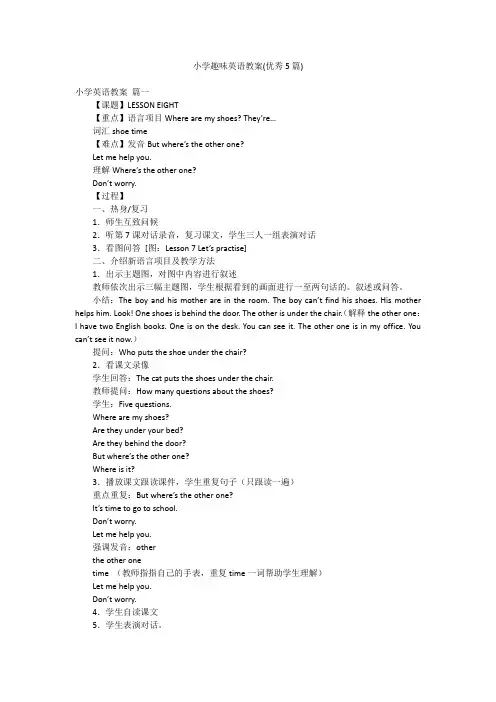
小学趣味英语教案(优秀5篇)小学英语教案篇一【课题】LESSON EIGHT【重点】语言项目Where are my shoes? They’re…词汇shoe time【难点】发音But where’s the other one?Let me help you.理解Where’s the other one?Don’t worry.【过程】一、热身/复习1.师生互致问候2.听第7课对话录音,复习课文,学生三人一组表演对话3.看图问答[图:Lesson 7 Let’s practise]二、介绍新语言项目及教学方法1.出示主题图,对图中内容进行叙述教师依次出示三幅主题图,学生根据看到的画面进行一至两句话的。
叙述或问答。
小结:The boy and his mother are in the room. The boy can’t find his shoes. His mother helps him. Look! One shoes is behind the door. The other is under the chair.(解释the other one:I have two English books. One is on the desk. You can see it. The other one is in my office. You can’t see it now.)提问:Who puts the shoe under the chair?2.看课文录像学生回答:The cat puts the shoes under the chair.教师提问:How many questions about the shoes?学生:Five questions.Where are my shoes?Are they under your bed?Are they behind the door?But where’s the other one?Where is it?3.播放课文跟读课件,学生重复句子(只跟读一遍)重点重复:But where’s the other one?It’s time to go to school.Don’t worry.Let me help you.强调发音:otherthe other onetime (教师指指自己的手表,重复time一词帮助学生理解)Let me help you.Don’t worry.4.学生自读课文5.学生表演对话。

小学生英语教案2022范文5篇小学生英语教案篇1教学目标:1、技能与知识目标(1)能听懂并会说、会读Good afternoon. 和What’s your name? I’m x x.的句型。
(2)能听懂并会说、会读词汇your, name, afternoon.2、运用能力目标能在不同时间段,正确地向他人问好。
(上午:Good morning! 下午:Good afternoon!)能用What’s your name?来询问他人姓名。
通过歌曲的学习培养孩子的乐感与美感,增强学科间的融合。
教学重点:能听懂并会说会读Good afternoon! What’s your name? I’m… 及词汇your ,name, afternoon.教学难点:name 中的/m/ 与afternoon中/n/的发音。
教学过程:一、Warm up1、运用所学问候语进行师生间,生生间对话练习。
“Good morning! I’m …” “How are you? I’m fine. And how are you? I’m fine ,too. Thank you.”2、同学们今天表现不错,那我们一起来做个游戏吧。
活动帮助学生分清“boys与girls”的用法。
速度由慢到快,指令可交替进行。
二、Lead inOK!boys and girls ,you’ve done a good job. Look!老师左右手各持一手偶,通过变换音调来演一段对话,引出本课重点:What’s your name ? 手偶1:Hi, I’m Mr.Li . What’s your name? 手偶2: Hello, I’m Sam.三、Text teaching1、同学们现在我是Mr.Li不是Ms.Liu,老师说话的声音变粗。
老师将Mr. Li的头饰带在头上与学生对话:Mr. Li: Hello! Good morning. Ss: Good morn ing. Mr. Li: what’s your name? Ss: I’m x x.2、播放一遍录音,要求学生听录音指图片。
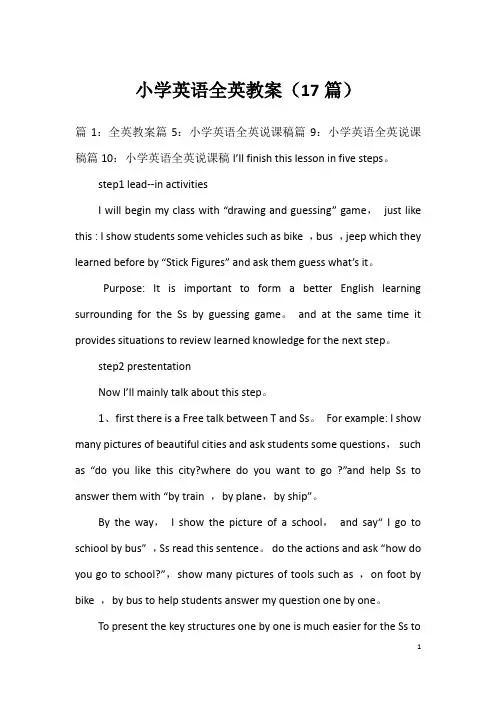
小学英语全英教案(17篇)篇1:全英教案篇5:小学英语全英说课稿篇9:小学英语全英说课稿篇10:小学英语全英说课稿I’ll finish this lesson in five steps。
step1 lead--in activitiesI will begin my class with “drawing and guessing” game,just like this : I show students some vehicles such as bike ,bus ,jeep which they learned before by “Stick Figures” and ask them guess what’s it。
Purpose: It is important to form a better English learning surrounding for the Ss by guessing game。
and at the same time it provides situations to review learned knowledge for the next step。
step2 prestentationNow I’ll mainly talk about this step。
1、first there is a Free talk between T and Ss。
For example: I show many pictures of beautiful cities and ask students some questions,such as “do you like this city?where do you want to go ?”and help Ss to answer them with “by train ,by plane,by ship”。
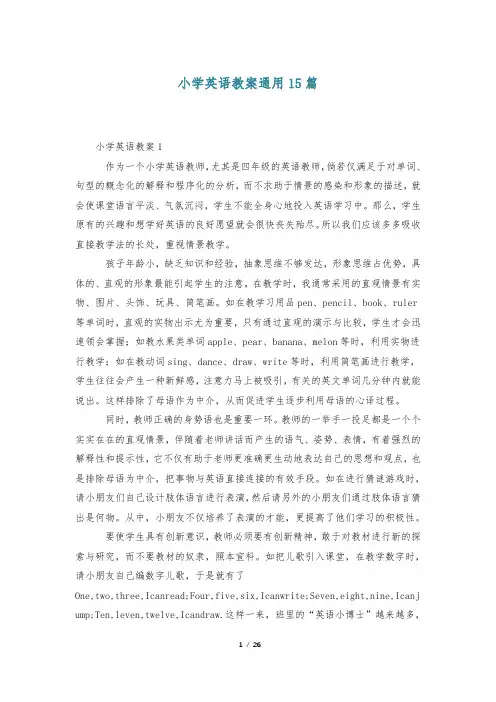
小学英语教案通用15篇小学英语教案1作为一个小学英语教师,尤其是四年级的英语教师,倘若仅满足于对单词、句型的概念化的解释和程序化的分析,而不求助于情景的感染和形象的描述,就会使课堂语言平淡、气氛沉闷,学生不能全身心地投入英语学习中。
那么,学生原有的兴趣和想学好英语的良好愿望就会很快丧失殆尽。
所以我们应该多多吸收直接教学法的长处,重视情景教学。
孩子年龄小,缺乏知识和经验,抽象思维不够发达,形象思维占优势,具体的、直观的形象最能引起学生的注意。
在教学时,我通常采用的直观情景有实物、图片、头饰、玩具、简笔画。
如在教学习用品pen、pencil、book、ruler 等单词时,直观的实物出示尤为重要,只有通过直观的演示与比较,学生才会迅速领会掌握;如教水果类单词apple、pear、banana、melon等时,利用实物进行教学;如在教动词sing、dance、draw、write等时,利用简笔画进行教学,学生往往会产生一种新鲜感,注意力马上被吸引,有关的英文单词几分钟内就能说出。
这样排除了母语作为中介,从而促进学生逐步利用母语的心译过程。
同时,教师正确的身势语也是重要一环。
教师的一举手一投足都是一个个实实在在的直观情景,伴随着老师讲话而产生的语气、姿势、表情,有着强烈的解释性和提示性,它不仅有助于老师更准确更生动地表达自己的思想和观点,也是排除母语为中介,把事物与英语直接连接的有效手段。
如在进行猜谜游戏时,请小朋友们自己设计肢体语言进行表演,然后请另外的小朋友们通过肢体语言猜出是何物。
从中,小朋友不仅培养了表演的才能,更提高了他们学习的积极性。
要使学生具有创新意识,教师必须要有创新精神,敢于对教材进行新的探索与研究,而不要教材的奴隶,照本宣科。
如把儿歌引入课堂,在教学数字时,请小朋友自己编数字儿歌,于是就有了One,two,three,Icanread;Four,five,six,Icanwrite;Seven,eight,nine,Icanj ump;Ten,leven,twelve,Icandraw.这样一来,班里的“英语小博士”越来越多,学习兴趣大大增强。
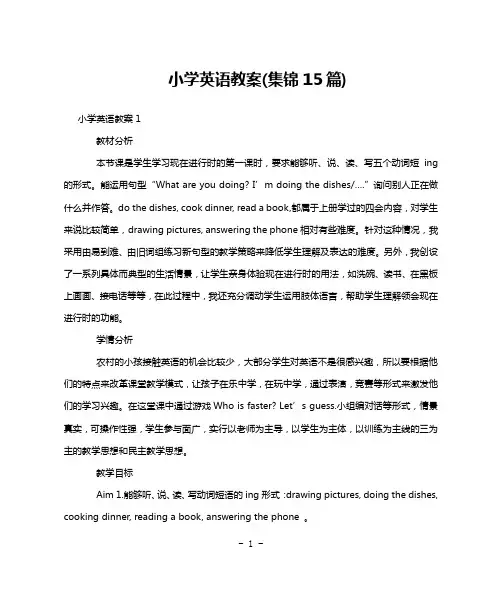
小学英语教案(集锦15篇)小学英语教案1教材分析本节课是学生学习现在进行时的第一课时,要求能够听、说、读、写五个动词短ing 的形式。
能运用句型“What are you doing? I’m doing the dishes/….”询问别人正在做什么并作答。
do the dishes, cook dinner, read a book,都属于上册学过的四会内容,对学生来说比较简单,drawing pictures, answering the phone相对有些难度。
针对这种情况,我采用由易到难、由旧词组练习新句型的教学策略来降低学生理解及表达的难度。
另外,我创设了一系列具体而典型的生活情景,让学生亲身体验现在进行时的用法,如洗碗、读书、在黑板上画画、接电话等等,在此过程中,我还充分调动学生运用肢体语言,帮助学生理解领会现在进行时的功能。
学情分析农村的小孩接触英语的机会比较少,大部分学生对英语不是很感兴趣,所以要根据他们的特点来改革课堂教学模式,让孩子在乐中学,在玩中学,通过表演,竞赛等形式来激发他们的学习兴趣。
在这堂课中通过游戏Who is faster? Let’s guess.小组编对话等形式,情景真实,可操作性强,学生参与面广,实行以老师为主导,以学生为主体,以训练为主线的三为主的教学思想和民主教学思想。
教学目标Aim 1.能够听、说、读、写动词短语的ing形式:drawing pictures, doing the dishes, cooking dinner, reading a book, answering the phone 。
Aim 2.能运用句型“What are you doing? I’m doing the dishes/….”询问别人正在做什么并作答。
Aim 3.通过说唱Let’s chant部分的歌谣巩固复习Let’s learn部分的动词短语和句子。
教学重点和难点本课时需要掌握五个动词短语的ing形式,能够理解下一课时的主要句型“What are you doing?”并能用“I am doing the dishes/…”作答。
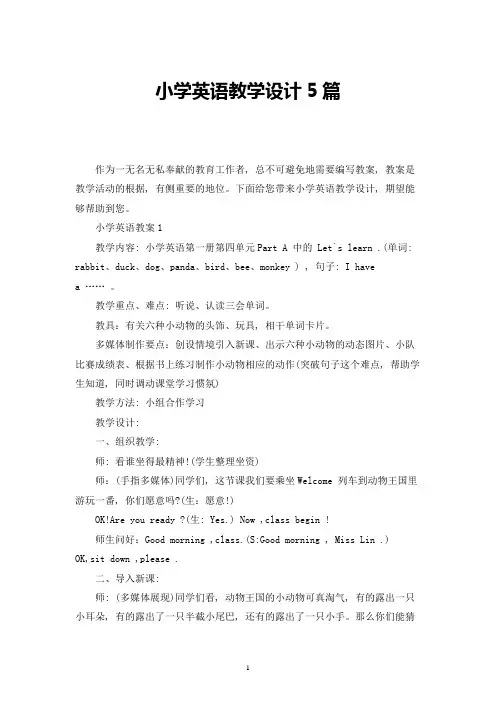
小学英语教学设计5篇作为一无名无私奉献的教育工作者, 总不可避免地需要编写教案, 教案是教学活动的根据, 有侧重要的地位。
下面给您带来小学英语教学设计, 期望能够帮助到您。
小学英语教案1教学内容: 小学英语第一册第四单元Part A 中的 Let`s learn .(单词: rabbit、duck、dog、panda、bird、bee、monkey ) , 句子: I havea ……。
教学重点、难点: 听说、认读三会单词。
教具:有关六种小动物的头饰、玩具, 相干单词卡片。
多媒体制作要点:创设情境引入新课、出示六种小动物的动态图片、小队比赛成绩表、根据书上练习制作小动物相应的动作(突破句子这个难点, 帮助学生知道, 同时调动课堂学习惯氛)教学方法: 小组合作学习教学设计:一、组织教学:师: 看谁坐得最精神!(学生整理坐资)师:(手指多媒体)同学们, 这节课我们要乘坐Welcome 列车到动物王国里游玩一番, 你们愿意吗?(生:愿意!)OK!Are you ready ?(生: Yes.) Now ,class begin !师生问好:Good morning ,class.(S:Good morning , Miss Lin .) OK,sit down ,please .二、导入新课:师: (多媒体展现)同学们看, 动物王国的小动物可真淘气, 有的露出一只小耳朵, 有的露出了一只半截小尾巴, 还有的露出了一只小手。
那么你们能猜出它们是谁吗?(学生纷纭举手发言)——猜, 是小学生的一大嗜好。
一石激起千层浪, 学生的热情被点燃。
师: 那让我们来看个究竟吧!(多媒体展现各种小动物的动态图片)——生动有趣的动画成效, 激起学生的学习爱好师:第一个出场的是谁……(在多媒体展现的进程中, 学生说出各种小动物, 老师借此板贴单词卡片)——结合个别学生课外参加补习班的情形, 而这一课的单词又比较常见, 很多同学能直接说出这些小动物用英语怎么说。
小学英语教案【优秀7篇】小学英语教案篇一一、教学目的:1.认识本书的主线人物:Lily、Bill、Angel、Andy、Joy and Lucky.2.培养学生学习英语的兴趣和良好的学习习惯和课堂常规stand up, sit down,sit up straight.3.早上问好等语言good morning!4.认识书籍每页有两部分。
A部分和B部分二、教学重点:认识本书的。
重点人物。
三、教学难点:培养学生良好的学习习惯和课堂常规。
四、课前准备:师备:录音机、教学录音磁带和六位主线人物图片。
生备:英语书五、教学过程:(一)导入:T: Hello ! boys and girls. I’m your english teacher. My name is wu lei .以后大家叫我miss wu .写板书1.介绍英语的重要性。
2.自己的愿望和理想。
3.小结:激发学生学习英语的兴趣(二)新授:T:今天我给你们带来了几位新朋友,让我们来认识一下:1.教师出示小女孩Lily的图片T:This is Lily。
Her name is Lily。
教师领读“Lily” T:Who is she ?What is her name ?以同样的方法教授:Bill、Joy、Andy、Angel and Lucky。
教师分别出示图片,要求学生跟学说出人物的名字。
巩固:用快速闪现的方法帮孩子进一步认识人物。
2.T:这两个小朋友非常有礼貌,听,他们在向你们打招呼T;Hello,__。
S:Hello,Lily/Bill目的:帮助学生进一步学习并掌握所学内容。
方法:1、师自问自答2、师领读hello3、师问生答(对于说得好的学生可以摸一摸老师手里的小朋友图片以示奖励。
)4、生问生答(三)进行课堂常规教育,主要是口令的听和做。
启发学生上课要认真听什么?听老师讲话,为什么,要让学生说出原因。
听同学讲话,什么时候听同学讲话,为什么要认真听。
小学生英语课程教案七篇小学生英语课程教案精选篇1一、教学目标:1、掌握there be结构所表达的意义。
2、能听懂和看懂包含there be句型的简短对话。
3、能运用学过词汇和there be句型来简单描述一下某处有某物。
二、重点难点:there be句型的肯定式、否定式一般疑问句及其回答方式。
三、教学过程:1、there be概念。
there be ...句型,表示的是“存在”,“某地有某人或某物”,其结构为there be(is,are)+某物/某人+某地。
2、be动词的用法。
单数名词和不可数名词用is,复数用are.3、there is的句子结构:there is a book on the desk.there is some water in the bottle. 5、there are的句子结构:there are some pictures on the wall. 6、练一练。
7、there be句型就近原则及练习。
四、小结及there be口诀。
小学生英语课程教案精选篇2一、教材分析:Let’s learn本部分主要学习4个有关文具的单词crayon, pencil, eraser, ruler。
单词是学生身边常用的物品,比较贴近生活,学习起来易产生学习兴趣。
Let’s chant部分通过有节奏、有韵律的歌谣,让学生进一步复习和巩固所学的词汇。
二、教学目标:1.能力目标:(1) 能用英语表达自己有的文具:I have a/an….(2)能吟唱Let’s chant部分的歌谣。
2.知识目标:(1)听、说、认读pencil, ruler, eraser 和crayon。
(2)理解Let’s chant的内容。
(3)能听、说句子I have a/an….3.情感目标:激发学生学习英语的兴趣,培养学生乐于开口,敢于开口讲英语的习惯。
教育学生要爱惜文具。
三、教学重、难点:1.重点:听、说、认读单词pencil, ruler,eraser,crayon.2.难点:crayon,eraser的发音,了解a/an的区别。
小学英语教学教案七篇模板小学英语教学教案模板【篇1】教学目标:1.认识汉字“鸭”和单词“duck”2.复习已经学过的单词,并且用游戏的形式进行巩固练习。
3.用双语的教学内容培养幼儿的关心别人的良好品质。
4.幼儿能够融入到英语游戏之中,并能配合教师积极参与到英语活动之中。
5.幼儿能够感受到英语学习的快乐。
教学准备:字母卡片、教学磁带、教学VCD教学过程:一、导入活动1.师生问好!2.玩捉迷藏的游戏。
3.今天老师带来了一个新的小动物,请小朋友猜一猜。
二、认识汉字“鸭”1.听汉字“鸭”的故事,并提问。
2.鸭宝宝的身上有个中国的什么字?鸭宝宝的头上有个外国的什么字?鸭宝宝正在干什么?3.师生一起表演这个故事。
三、认识单词“duck”1.听单词的故事,并提问:(1)鸭宝宝从农场回来后从谁的头上飞了过去?(2)鸭宝宝飞到什么里面把水喝完了?(3)谁看见了很生气地批评了鸭宝宝?(4)小朋友,你们认为鸭宝宝这样做对吗?2.集体观看单词儿歌动画片。
3.表演单词的字母组成故事。
四、听音拍手游戏。
小学英语教学教案模板【篇2】教学重点:1.掌握字母的发音和书写。
2.巩固数字30-60的拼读。
教学难点:1.Jj, Gg; Bb, Dd; Ii, Rr; Mm, Nn几组字母在发音上易混淆。
2.B, d; l, j; p, q; u, v在书写时易写错。
3.Sing and read中出现了三个新单词:jet, sugar, X’mas.要让学生做到能认读。
4.Let’s practise中两道加法题的结果出现了55、60,而前面只学到50。
教具准备:1.字母卡、加法算式卡2.有关学习物品的图片或实物。
3.Read and say部分的自制课件。
4.教材相配套的的录音带教学过程:(一)热身/复习(Warm-up/Revision)1.复习第二册教材第65页的Let’s chant。
2.做“抢读字母”的游戏。
这是一个训练学生认读字母的游戏,教师将全班分成若干小组,然后逐个出示字母卡片,学生们举手抢答,教师让最先举手的学生读出该字母,读对的给该组记10分,最后得分最多的组为优胜。
小学英语优秀教案设计(5篇)小学英语优秀教案设计(5篇)你们拥有无限的潜力,只要你们用心学习,努力奋斗,一定能取得优异的成绩。
下面是小编为大家整理的小学英语优秀教案设计,如果大家喜欢可以分享给身边的朋友。
小学英语优秀教案设计(篇1)一、教学目标:1. 能够听、说、读、写词语:drew(draw的过去式), piece, paper 和scissors.2. Target Language:I drew a dragon on a piece of yellow papeI painted it.二、教学重、难点:1. 重点:重点掌握4个四会单词。
用英语描述大明制作风筝的过程。
2. 难点:几个动词的过去式,了解词语:sticks 和 strings 的意思。
三、课前准备:1. 单词卡片,彩纸等。
2. 多____课件。
四、教学过程:1.greetings:2. warm up:Enjoy a chant and do the actions:Black,black. Stand up.Pink,pink. Sit down.Brown,brown. Touch the ground.Orange,orange. Touch the head.White,white. Turn around.(在此活动中同学们利用课前领到的彩纸来配合做动作,既活跃了课堂气氛拉近了师生间的距离,也为后面的教学打下了基础)2. 新词呈现:T: Boys and girls, I have so much colorful paper. Look, a piece of red paper, a piece of yellow paper, and… 引导学生回答a piece of green paper… 接着板书a piece of 并学习,然后让学生利用自己手中的彩纸来练习a piece of yellow/red/green paper等等。
小学英语教学教案(通用10篇)小学英语教学教案篇1教学内容:Let’s say and Let’s sing教学目标:1、知识目标a)学生能够熟练听读、认读课文主人翁的英文名b) 学生能能熟练运用句型: Hello, Good morning,I’m … What’s your name?2、技能目标学生能够用英语自我介绍和询问别人。
鼓励学生积极参与活动,激发学生学习英语兴趣,增加他们的自信心。
3、情感目标a)在活动中,教师与学生的积极互动,营造民主和谐的英语学习氛围,学生能在英语课堂中快乐地学习。
b) 通过一些活动,培养学生合作意识。
激发学生学习英语的兴趣,鼓励学生积极参与活动,培养学生运用灵活运用英语的能力,养成活学活用的习惯。
教学重点:a)学会打招呼b)学会唱歌教学难点:缩写形式的读音教学方法:1、游戏教学法:学生通过游戏掌握本堂课的单词和句型。
在本课堂中,教师通过猜人物、表演对话等活动对单词和句型进行操练。
2、TPR全身反应法:结合低段小学生的性格特点,给相应的情节配上相应的图片和动作。
在活动中加强学生对句型的运用。
提高学生的学习兴趣。
3、实践行动法:以日常生活中打招呼的情景,操练学生口语能力。
4、歌唱教学法:通过教唱歌曲和随机改编歌曲,既可以激发学生的学习积极性,又可以巩固和复习本节课所学的内容,让学生记得更深刻和更牢固。
歌曲使人轻松、快乐。
歌曲使人记忆深刻,通过歌唱学习英语能长久记忆。
老师唱问,学生唱答,一唱一和,快唱快和,慢唱慢和,灵活贯通。
使教师和学生都感受快乐。
教学设备:老师自制的教具单词翻卡,多媒体设备教学过程:Steps Teacher’s Activities PurposeStep1 Greeting1. Greeting with Ss.2. Divide the class into two groups, boys group and girls groups. and show Ss the rules of petition. and tell Ss who can get the top of the ladder and who will be the winner of the petition. 通过分男、女组比赛,设计“分红旗”的竞赛情景,来调动学生的学习激情。
小学英语优秀教案(优秀7篇)小学英语教案篇一教学目标:知识与技能:能够听懂、会说、会认读单词:man, father, dad。
过程与方法:能够听懂、会说、会认读句型:who’s that man? he’s my father./ hi, dad.并能够在具体的语境中灵活运用。
情感态度与价值观:能够听懂指令,按照指令的要求完成point and say的内容。
教学重点:掌握三个单词和句子。
教学难点:能够理解和运用句型:who’s that man? he’s my father./ hi, dad.并能够听懂、会说、理解句子:this is my friend, amy.教学准备:照片,词卡教学过程:step1 warming up revisiona song” who is she?”(网络素材)。
a song “boy and girl”。
’s chant:p8.my friends.引导学生介绍自己的朋友。
如:hi, i’m ’m from chin is my friend, ’s a ’s a ’s from china/ the uk/ canada/ the usa/ australia. step2 presentation practice1、以旧带新,学习新知(let’s talk)(1)教师:呈现mr jones,问:who’s he?引导学生答:he’s mr jones.教师:mr jones is a man.(2)学习单词man,并扩展woman对比进行学习。
2、词融于句,巩固新知活动1:呈现男教师的照片,让学生练说: mr… is a man.活动2:呈现男明星的照片,让学生练说:如yao ming is a man. and learn(1)呈现教师自己爸爸的照片:look, that is a ’s that man? can you gu?教师出示答案:he’s my father.(2)学习father,并扩展mother对比学习。
小学英语主题教案
一、教材内容分析
学生刚刚接触到英文的26个字母,对相似字母的辨识还存在着一定的误差,所以教材在Start to read部分安排了字母辨识的环节,例如b和d, Q和D等,目的在于检测和巩固学生对于字母的认识。
本节课的另外一个主要目标是复习和巩固之前所学的`一些文具的单词以及打招呼,告别,自我介绍用语等,所以在Read and count, Listen and number和Look and match这三个环节都以此为练习的主要内容,学生通过练习可以有效的巩固和复习本单元所学的核心词与句型。
二、学生情况分析
本课教学对象为小学三年级学生。
他们初步接触到英语,对英语的听说感兴趣。
经过前几个课时的学习,学生已经学习了26个英文字母和常见的几种文具,以上是学生学习本课内容的基础。
三、教学目标
1. 能够辨认字母的形。
2. 能够认读本单元的核心词:ruler, eraser, pencil, crayon, bag, pen, pencil box, book。
4. 能够学会唱歌曲Hello。
四、教学重难点
教学重点:
听说、认读ruler, eraser, book, pen, crayon, pencil box, bag等文具的名称。
教学难点:
在真实的场景中应用句型I have … 和Me too.
五、教学步骤
1. 热身
(1)教师与学生进行自由对话:What’s your name? My name is … 既可以巩固本单元句型,同时为下一步歌曲的呈现铺垫。
(2)教师播放歌曲Hello,和学生一起演唱,并让学生从歌曲找出三个人物的姓名。
(3)请孩子们回答他们的姓名,同时教师呈现Mike, John, Sarah和三个一模一样的书包。
请学生根据人物对于自己书包内文具的描述来确定是谁的书包。
设计意图:通过自由对话来复习已学句型,同时拓展与铺垫歌曲内容,通过听轻松愉快的歌曲,带着找出人物姓名的任务,再通过猜谜小游戏既复习已学单词,同时感知重点句型。
T: Good morning, boys and girls.
Ss: Good morning, Mr. Dong.
T: Nice to meet you again, what’s your name?
Ss: My name is Angela.
T: Hi, Angela, What a nice name, I like it so much!
S: Thank you!
T: What about you?
S: My name is James.
T: Wow, cool! I like your name too.
S: Thank you.
T: Ok! Everyone has a nice name. Let’s listen to a song and find some nice names, ok?
Ss: Ok.
T: (教师播放歌曲Hello) who can try? What names do you hear in the song?
T: look at the three bags, listen and guess whose bag it is?
文本:Mike: I have a pencil box and two books.
John: I have a ruler and two erasers.
Sarah: I have a pen and a crayon.
2. 呈现
(1)听指今做动作
①教师发出指令:show me your … 孩子们根据不同的指令拿出相对应的文具。
(已经给三个人物找到了各自的书包)
T: They have pens, books, rulers, eraser and crayons in their bag. What about you? Let me see, ok?
Ss: Ok.
T: Show me your pen!
学生拿出笔。
②教师从自己准备的书包中拿出一本书,并指着自己说:I have a book. 并以此形式展开几种文具。
③请孩子们用自己的文具来说:I have a … 当孩子说到I have a book. 时,教师则举起自己的书说Me too! 告诉学生如果你有与别人东西相同时,可说Me too!
T: Look! Boys and girls. I have a book. I have two pens, I have a ruler, I have an eraser and I have three crayons.
T: Who can have a try, tell us what do you have?
S: I have four pens, I have one eraser.
T:(教师举起一块橡皮)Me too.
设计意图:通过指今与实物相对应的环节,呈现并复习上节课所学的单词。
通过教师的演示与学生的示范,帮助学生理解并应用句型I have a…, Me too。
(2)Let's chant(看图唱韵律诗)
T: Look at the picture, let’s chan t together!
(3)Let's make a new chant(编出新韵律诗)
T: Look at me, let’s make a new chant!
T: (教师手中拿出相对应的文具,同时在黑板上板书)I have a crayon, me too。
3. 操练
(1)Read and count (读一读,数一数)
教师先引导学生读出树干上的文具单词,再请学生数一数每种文具单词的数量,并标示出来。
T: Open your book and turn to page 9. Count them and write it down, you have 2minutes, go!
S: I see two pens …
(老师请学生代表回答)
(2)Circle the same letters
教师请学生圈出一行中相同的字母,并要求学生数出字母的个数。
(已经完成Read and count的活动)
T: Can you find same letters? For example, there are three letter “a” in line1. Have a try!
T: Count them! How many letter “a” are there?
设计意图:通过课本中的练习进一步巩固重点单词,并渗透名词单复数用法。
通过圈出相同字母的环节,让学生能够辨认字母的形。
(3)let’s check
教师先请学生观察4幅图片,教师播放录音,然后再请一两个同学说出答案。
(已经完成circle the same letters的活动)
T: Look at the pictures on page 10, please listen and number the pictures, let’s go!
T: Ok. The first one is open the book. So picture 3 is number1.
(老师请学生代表回答)
设计意图:通课本中的对应练习,检测并巩固学生对于打招呼,告别等行为的用语。
(4)Look at match
(已经完成Let’s chek的活动)
T: Look at the balloons on page 10, please listen and number, let’s go!
(老师请学生代表回答)
设计意图:通过课本的对应练习,巩固学生对于单词形和意的认知。
六、板书设计
简单的板书设计描述,说明板书的书写过程。
后附板书设计图。
见例:
整个板书以书包为背景,并且展示书包内的各种文具。
在操练环节,学生表达I have …教师在黑板上贴出相对应的文具并回答Me too. 最后以此来进行整节课的小结。